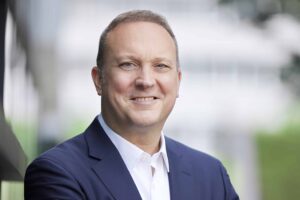By appointing Dr. Christian Schmeichel as chief future of work officer, SAP is one of the first corporations in the world to make the topic a strategic priority. In a post-pandemic world, what kind of work environment can SAP employees expect?
The phone call came on a Friday night, Schmeichel remembers: “Did I want to go to Japan as HR director? I was given time to decide until Monday.”
At the time, Schmeichel already had a track record of various HR executive roles at SAP. Born in Cologne, Germany, he acquired a PhD in Business Administration and went on to work in corporate finance and as a strategy consultant with a McKinsey spin-off. In 2005, he joined SAP where his roles included, among others, head of HR strategy, COO for HR, and HR business partner lead for four SAP Executive Board members.

Moving to Tokyo in 2013, Schmeichel encountered a country undergoing fundamental change after the Fukushima earthquake, tsunami, and nuclear catastrophes. “It was fascinating to see this huge country gearing up to be prepared for potentially disruptive events of the future,” Schmeichel says. There was a deep business transformation underway with a focus on rebuilding things as some regions of Japan had been completely destroyed.
“But it also left a lasting impression with me how strongly people’s safety featured in all those considerations. With the catastrophe being so fresh in everybody’s mind, there was a fundamental focus on health and well-being – on what’s really important in our lives.”
Schmeichel’s years in Japan certainly provided a learning experience for turbulent times such as the global pandemic a few years later and his new role as chief future of work officer.
SAP’s Holistic Future of Work Agenda
With the creation of the chief future of work officer position in 2021, SAP became one of just a few other companies to have someone managing this topic holistically at the C-suite level. Given Schmeichel’s more than 20 years in HR executive roles, this was a perfect opportunity for him to bring together all his expertise and knowledge to make sure that SAP is a front-runner in this important area.
“Historically, SAP has a track record of creating state-of-the-art, leading-edge working environments,” he says. “But with the world changing at breakneck speed and the war for talent becoming even more intense, we at SAP – just like any other corporation – have to get one thing right and that is continuously being an attractive employer moving forward.”
Schmeichel considers the global pandemic as a catalyst for workplace change that was already underway. “What started out as crisis management in March 2020 evolved into our innovative flagship program Pledge to Flex, among other things,” he says.
He regards SAP’s workplace flexibility as an advantage over competitors that have announced that they will mandate their employees come into the office again several days per week. With its Pledge to Flex program, SAP chose a more flexible approach. The hybrid working model is a frame in which everyone – in line with business requirements – is empowered to find the best balance between working regularly in the office and remotely.
“The combination of flex time, flex location, and flex workspace opens doors for talent that we otherwise couldn’t tap into,” Schmeichel explains. “We don’t want to miss out on an awesome developer, just because they are also taking care of young children or elderly relatives.”
A mix of data-driven insights and feedback from SAP employees enables Schmeichel and his team to learn how their initiatives are being received. “Almost 90% of our employees confirm that Pledge to Flex is the right way to go,” he says. “We are currently making sure that the program becomes a reality for all our 105,000 employees across all of our 75 countries.”
For employees, more flexibility also means more responsibility and self-organization though, while managers need to come up with new and modern ways of holding the team together and checking in on team members. Schmeichel and the Future of Work team understand this can lead to additional strain, but also great opportunity for enhanced performance.
“Health – and mental health in particular – are important parts of the holistic Future of Work team’s agenda,” he says. “We have to make sure that people are able to work in a sustainable way.” With initiatives such as “Are You OK?”, SAP Mental Health Day, or SAP’s mindfulness practice, the company encourages its employees to self-reflect on what is important in life for them and also take a particular look on their mental health and well-being.
A Deep Glimpse into the Crystal Ball: Creating a Target Picture for the Future-Proof SAP
But the future of work at SAP encompasses much more than adjusting to the new post-pandemic normal. One of the most important steps to undertake when gearing up for the future is to create a strategic target picture. Taking an evolutionary approach for SAP’s workforce planning, Schmeichel’s team develops a vision of what SAP could look like five to 10 years from now.
“If we know, for example, the future ratio between permanent and temporary labor, the future skills demand, or the mix of locations people will work from, we can derive from that how our people strategy and our workplace practices will need to evolve,” he says. “Hiring practices, location strategy, learning strategy – all that needs to be part of an evolving future of work agenda.”
With a clear picture of the current and future workforce and the anticipated changes in work practices and environment, it becomes obvious that HR has to evolve as well.
“If we want to serve our SAP workforce to the best extent as an HR organization over the upcoming years, we will need to leverage our digital capabilities much more. We need to simplify topics wherever it makes sense to free up time and capacity for value-adding services such as talent management or personal conversations,” Schmeichel says.
The strategic workforce planning part of the Future of Work team is closely collaborating with SAP business leaders, HR business partners, as well as controlling and corporate strategy. Key figures such as headcounts and financials are going into the target picture, but also information on the skills the workforce will need to develop.
Schmeichel explains: “We still cannot predict the future, but we can maybe ask the right questions to come up with good answers and scenario planning to have a better grasp of what may happen.”
Leading the Way for Customers and Partners
As chief future of work officer, the overall vision and mission of Schmeichel and his team is to support SAP’s own business transformation while also positioning SAP to drive other companies to become intelligent and sustainable enterprises.
“Right now is probably a once-in-a-generation opportunity that might bring us as a society to the next level, rethinking the way how we live and work for the better,” he says. “We are laying the strategic groundwork today and it’s important that we don’t lose the momentum the global pandemic gave us in this regard.”
Other companies are looking to SAP for inspiration on how to manage the future of work topic holistically, including the ways in which SAP is leveraging its own technology.
“We share with our customers how we are doing it,” Schmeichel says. “A question I often get is how SAP’s Future of Work team is organized. In fact, we have set up ourselves in agile topic clusters that cover all our important subject matters such as strategy, innovation, workforce planning, Pledge to Flex, future of work insights, health and well-being, people technology, and so on. We have flat hierarchies so we can strategize and execute very fast.”
He adds, “Getting to shape the future of work right for SAP as one of the most exciting companies and to an extent also for our customers and partners is something I’m very passionate about. But working with my team that shares this vision is what really puts the fun in what I’m doing. And that’s very appropriate as, at the end of the day, future of work is also about having a fun workplace.”



